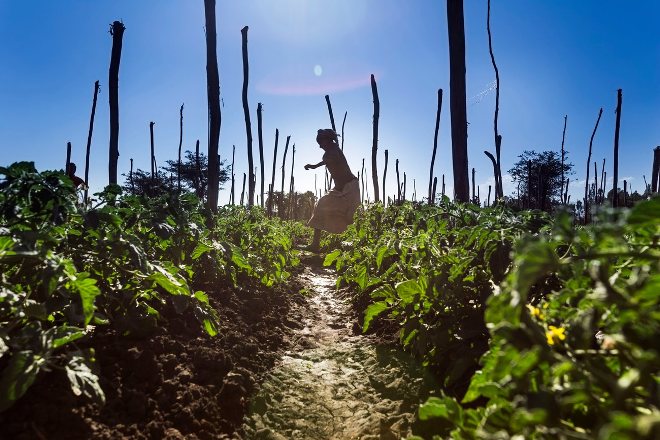
Thursday August 18, 2016
As drought sweeps many countries in Africa, an initiative led by water NGOs supports the use of underground aquifers. But the idea is controversial

12-year-old Fatimo runs home after school through a groundwater irrigation project near Ziway, Ethiopia. Photograph: Petterik Wiggers/IMWI
Despite recent heavy rains, Ethiopia is still reeling from the worst drought to hit the country for half a century, particularly in the livestock-dependent regions of Oromia and Somali. Yet studies (pdf) suggest the country could have billions of cubic metres of untapped groundwater.
The story is the same across many parts of Africa, where farmers rely on erratic rains and depleted surface water while potentially vast groundwater reserves go ignored. Africa’s subterranean water amounts to an estimated 660,000 cubic kilometres (pdf), according to research from the British Geological Society – more than 100 times the continent’s annual renewable freshwater resources.
A new initiative co-led by the International Water Management Institute (IWMI) is aiming to mobilise support for greater use of Africa’s under-used aquifers. Developed in the wake of targets set at the UN Sustainable Development Summit and the Paris climate talks last year, the goals of the Groundwater Solutions Initiative for Policy and Practice (GRIPP) include leveraging $1bn (£770m) of investments in sub-Saharan Africa for sustainable groundwater irrigation and improving groundwater access in the region for 4m rural households.
The idea is timely given widespread drought across southern and eastern Africa, yet it is not without controversy. Decades of overexploitation in north Africa (pdf), where groundwater is more abundant, have left many sedimentary aquifers dangerously depleted and in some cases degraded by saltwater intrusion. In Morocco, for example, the water table of the Saïss deep aquifer – one of north Africa’s largest aquifers – has fallen by an annual average of 3m over the past 20 years.If the right policies and incentives are in place, however, groundwater can be exploited sustainably, argues Jeremy Bird, director general of IWMI.
Not only is groundwater more locally available and more reliable than rain in many parts of Africa, says Bird, it also serves as a better buffer to climate shocks: “It provides an opportunity for farmers to move one step up the ladder from very uncertain rain-fed irrigation, which is subject to the vagaries of climate, to supplementary irrigation, which offers them the ability to provide water when the crop really needs it.”
Improving Africa’s irrigation infrastructure has long been a goal of national policymakers and development agencies. The World Bank, for instance, is currently trying to mobilise international funders to help double irrigation levels in six countries in the drought-prone Sahel region.
The Sahel Irrigation Initiative Programme, with input from IWMI, is now considering the use of simple, farmer-managed pump bores alongside its focus on more expensive canals, reservoirs and other centrally-managed surface water infrastructure projects.
Vincent Casey, water, sanitation and hygiene senior adviser at WaterAid, however warns these simple pumps must be managed well: “Despite the advantages of convenience and affordability, the scale of pumping is very difficult to regulate which inevitably has economic consequences when groundwater is depleted.”
Africa may have considerable untapped aquifers, but not all are able to be easily and affordably accessed, says Casey. “Rural electrification has been limited, discounting the possibility of politically motivated energy subsidies that could make high powered pumping affordable to small scale farmers”. Capacity for groundwater withdrawal is also hampered by a lack of reliable hydro-geological data (Ethiopia has mapped less than one quarter of its groundwater resources) and relevant expertise.
All these factors contribute to a patchy experience of groundwater projects to date. According to UPGro – a DFID-funded research programme examining groundwater in sub-Saharan Africa – nearly one third of such projects in sub-Saharan Africa fail within a few years of construction. The World Bank puts the estimated cost of groundwater project failures at more than $1.2bn (pdf) in lost investment over the last 20 years.
The main aim of GRIPP, which is focusing on projects not just in Africa but around the world, is to correct this trend through the promotion of research and knowledge-sharing around sustainable groundwater withdrawal practices and policies.
A vital step in this respect centres on farmer buy-in, says Ugandan water planning expert Callist Tindimugaya, vice president of the International Association of Hydrologists, a GRIPP partner. Because groundwater is an “invisible commons”, he argues, farmers struggle to know what comprises sustainable usage. Government provision of cheap power for water pumps and other price incentives to promote agricultural productivity can lead to overuse as well, he adds.
“Local initiatives to co-manage the resource are increasingly being explored as an important element in sustainable groundwater use as farmers realise their common interest in safeguarding the resource,” says Tindimugaya.
A case in point from another part of the world is in the Indian state of Andhra Pradesh, where farmer groups in over 700 communities agreed to collectively monitor groundwater levels, to plan their crop planting jointly and to adopt water-saving techniques. The project, which ran from 2003 to 2009, successfully reduced overexploitation (pdf) in the semi-arid state. Since the project ended, however, and without adequate governance systems in place, most of the farmer-led initiatives have ceased.
Policymakers might find incentives the best initial defence against unsustainable abstraction, says Bird. He cites a pilot project in the Chinese province of Shanxi, where farmers access set volumes of water from the state-run pumping system with pre-paid smartcards. If they use less than their quota of pumping time, they can trade it with other farmers.
“Our role is to identify the types of policies which might work in a particular situation, learn lessons from other areas and then assess the impacts of these policy decisions over time and see what the implications have been,” says Bird.